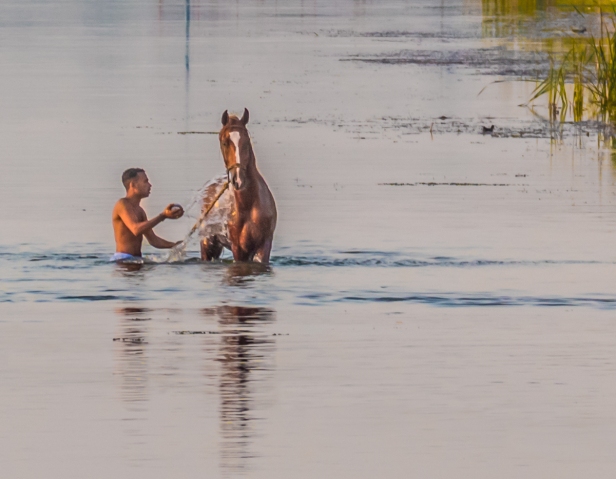
18-20 October 2015. We have no idea what to expect. We have spent the night docked at the town of Edfu about one hundred kilometres south of Luxor. We leave the cruise boat very early in the morning. The first thing that draws my attention is a couple of men washing their horses in the river – a slice of daily life. Next we discover that we are to ride to a temple in a horse-drawn carriage. It sounds so regal, but the reality is of course much more prosaic. We all scramble to find a carriage and climb aboard. Our guide orchestrates it all and arranges payment so there is no fighting off over-enthusiastic chauffeurs. It is one of the advantages of being on a tour, especially in Egypt where hawkers are relentlessly pushy. 
Our driver’s name is Abdullah. His horse, Samir, alternates between walking, trotting, and cantering. It’s a bouncy ride. And fun. Abdullah says several times very good English, very good English, though clearly this is not the case.
We pass through the quiet early morning streets of Edfu and once again I’m aware of how much Egypt reminds me of India. Only the costumes are different.
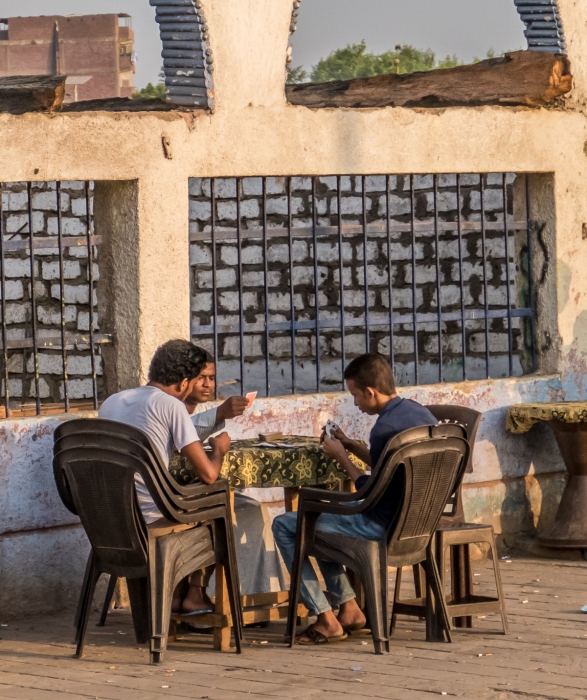


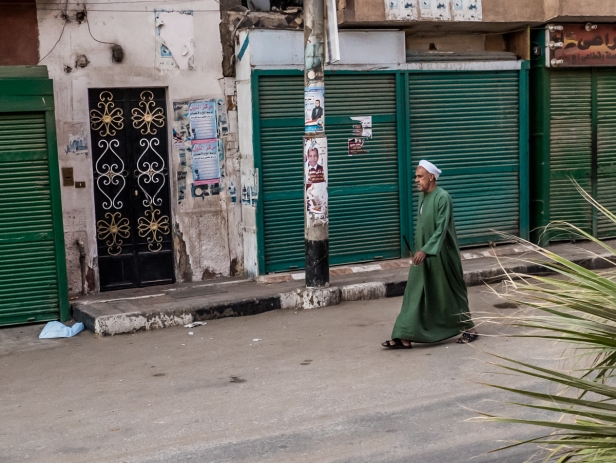
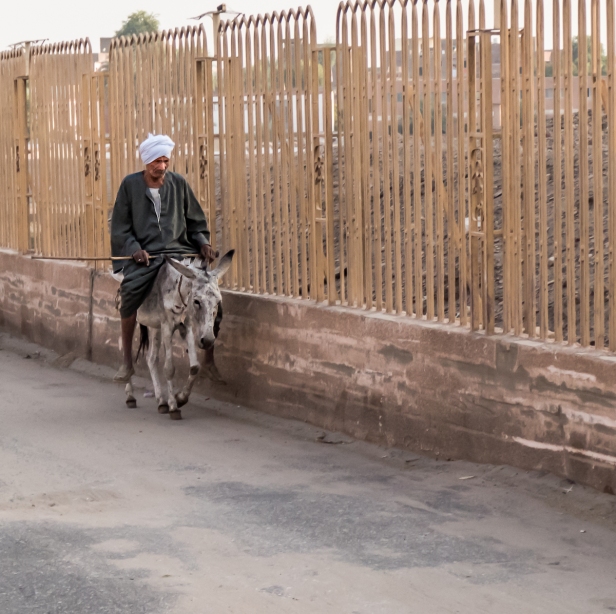
For several decades from around 237 BCE Egypt was ruled from Alexandria by Greco-Roman kings. The Greco-Roman kings presented themselves as pharaohs and imitated the traditions of Egypt. They were smart enough to allow the Egyptians to continue with their own spiritual practices, which happily included worshipping the pharaoh as a god.
The Horus Temple at Edfu was built during this period. It is the second largest of all Egypt’s ancient temples and is dedicated to the falcon god Horus, and his wife Hathor the cow goddess.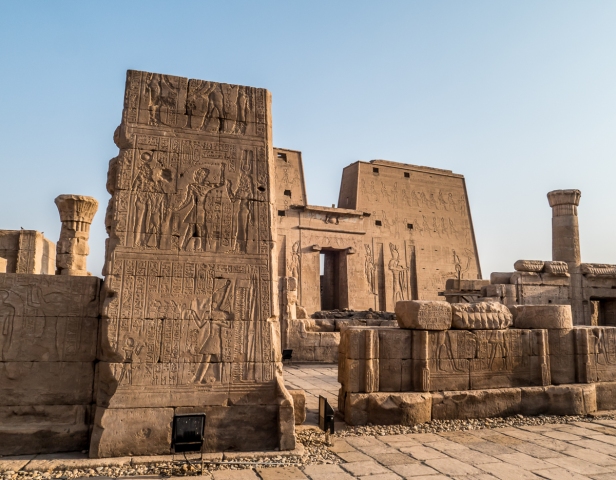
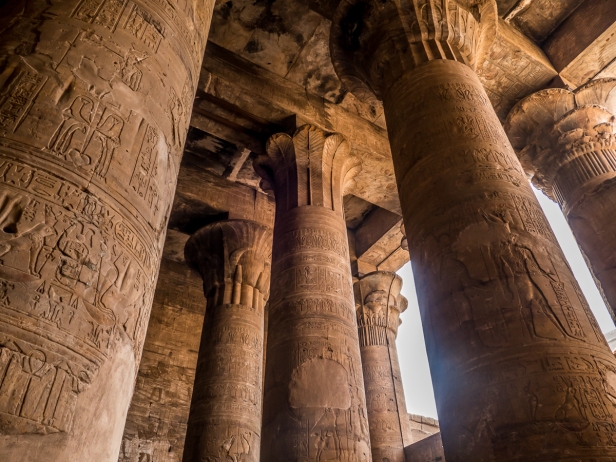
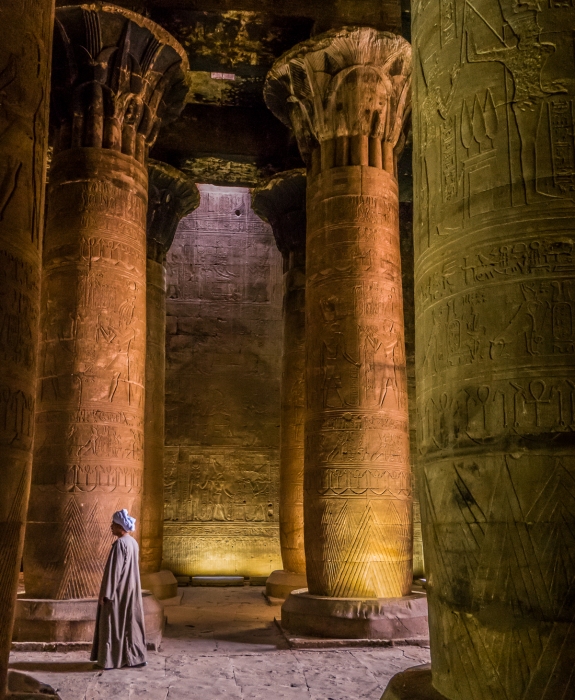
On the walls of the Temple of Horus are a total of 1811 hieroglyphic texts,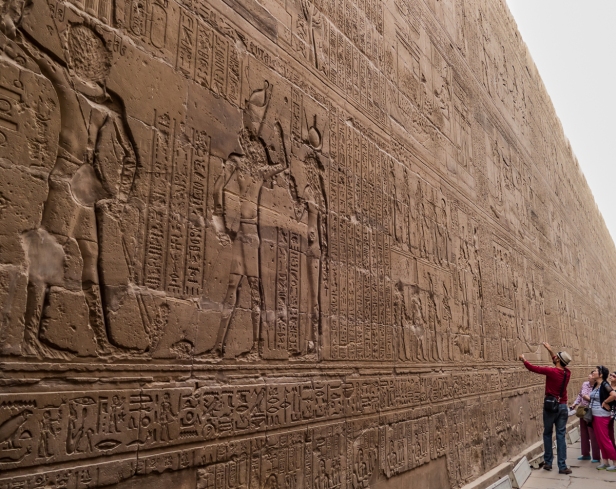

including one wall in a small room covered with instructions for making ancient perfumes. People are still making these perfumes today.
Horus was the divine son of the sibling gods Isis and Osiris. Their brother Seth, the evil one, killed Osiris. When Horus was grown he avenged his father’s murder by killing Seth and then took the throne in the pantheon of gods.
The texts in the Temple of Horus include the telling of a Mystery Play, which was performed as part of a religious ritual. In this ritual Seth appears as a hippopotamus lurking beneath his brother’s boat. At the end of the play, the priests cut up and eat a hippo-shaped cake. I am immensely amused by this. However when I was travelling through Africa thirty-five years ago I did learn how dangerous hippos can be. They wallow, almost hidden, in the rivers, and they can upturn a boat in second, so the hippo as a symbol of danger makes sense. But a hippo-shaped cake? Seriously? I suppose the symbolism of eating it is to destroy the evil one and gain power over the danger. I missed the hieroglyphics showing the hippo-shaped cake, though I don’t doubt their existence.
High on a hill near the temple I see the working day has begun,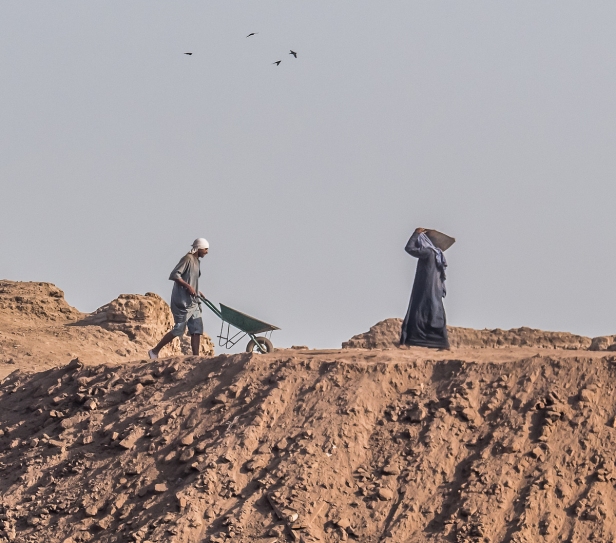
and as we return to the boat from the temple we see a different Edfu – now more awake as people go about their daily activities. 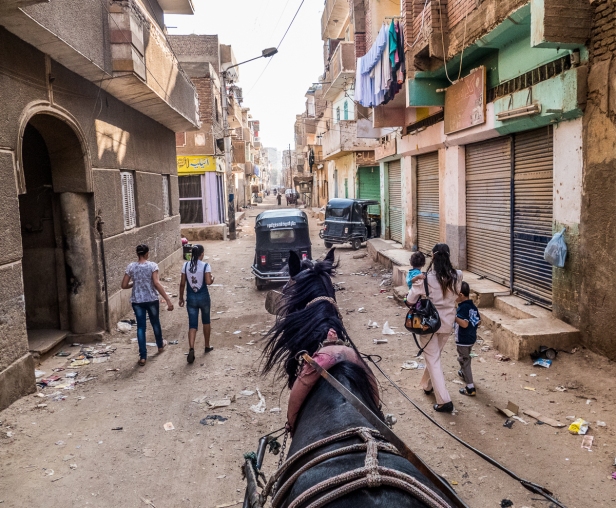
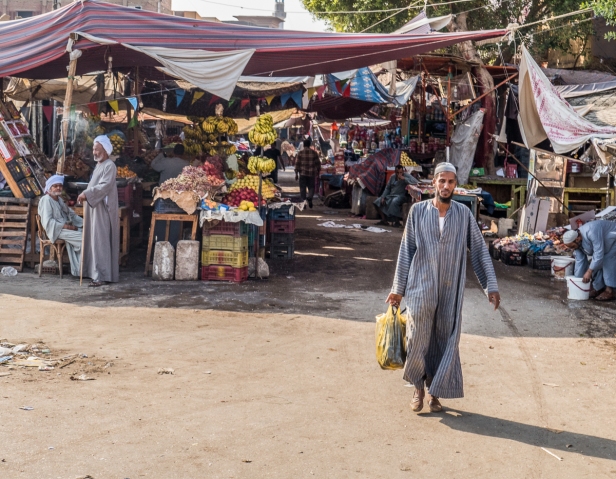
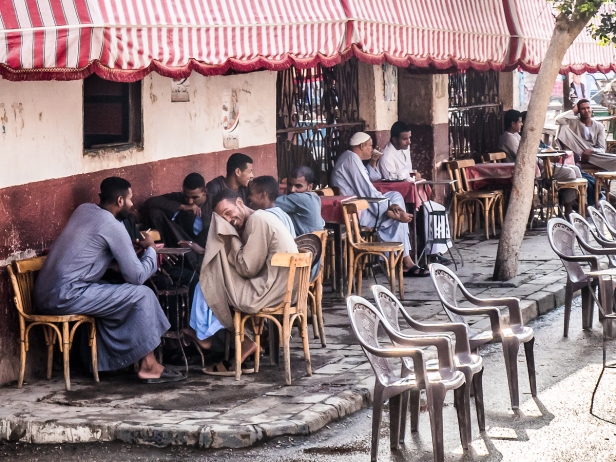



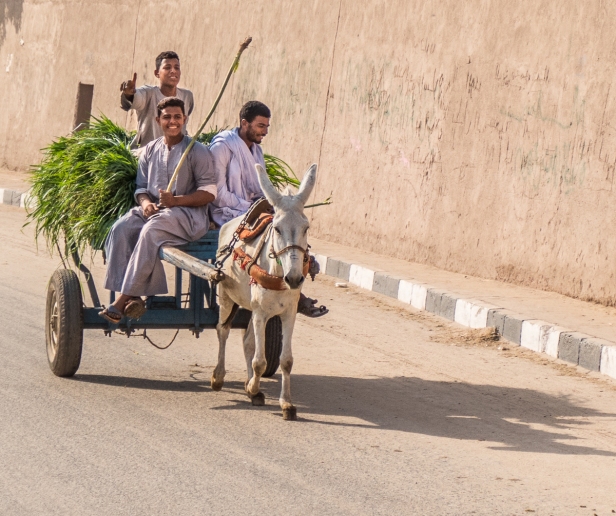
There is no word for queen in the ancient Egyptian language so when Maatkare Hatshepsut claimed the throne in 1503 BCE, instead of passing it on to her stepson when he came of age, she simply called herself king. She styled herself as a king and had herself depicted with a pharaoh’s kilt and beard in order to legitimize her position.
She reigned for nearly twenty-two years and is possibly the earliest known ruling queen. In comparison Tutankhamun only reigned for ten years, and Ramses IV for only six. During her reign she reestablished trade routes and commissioned hundreds of construction projects. She is generally regarded as one of the more successful pharaohs. Clearly she was a force to be reckoned with.
The Mortuary Temple of Hatshepsut, known as the Holy of Holies, is unlike any other Egyptian temple from antiquity. It is situated at Deir el Bahari, near the Valley of the Kings and is considered one of the premier monuments of ancient Egypt.
For visual impact from afar there is no comparison. The unique multi-tiered structure sits directly against the limestone cliffs, which form a natural amphitheatre around it, so the temple seems to emerge from the rock. From afar it draws you in.
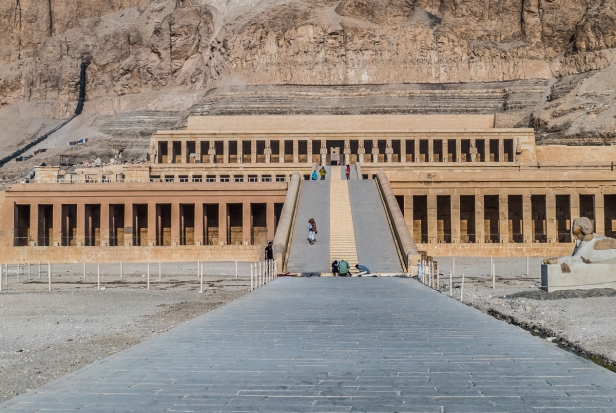
There are statues of Hatshepsut as king along the pillars of the upper level,
and an uninterrupted view across the valley.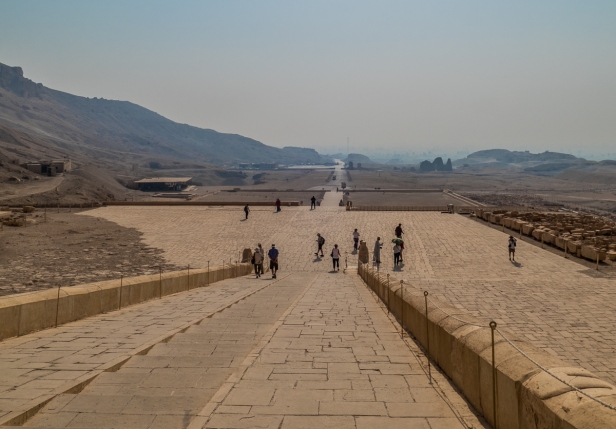
Inside, the paint has survived for three thousand years giving a hint of its original brilliance.

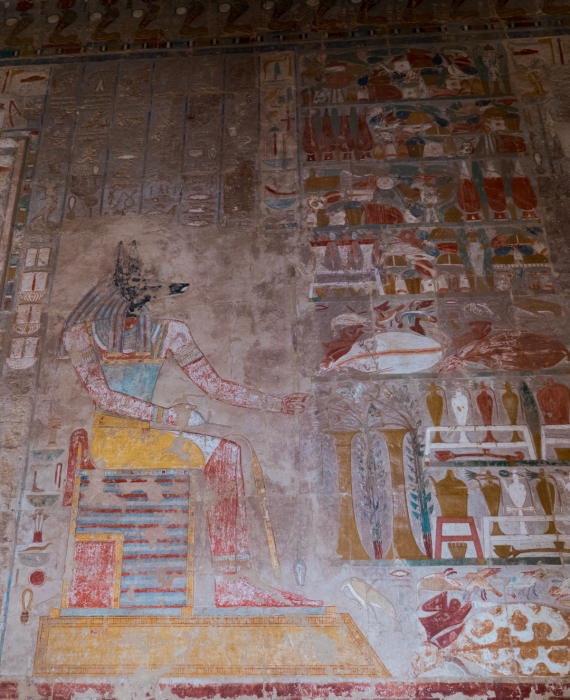
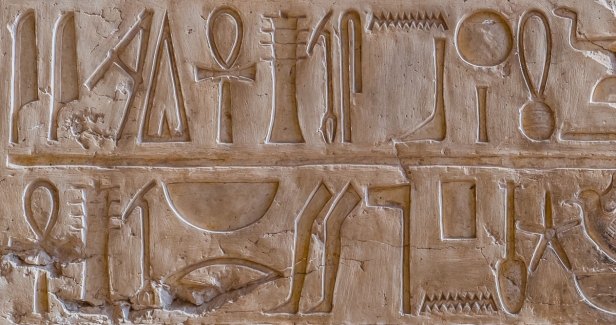
I longed to see Egypt’s ancient monuments as they would have looked when they were new and vividly coloured. My dream comes true in the Valley of the Kings.
On the western bank of the Nile, and beyond the cliffs behind the Temple of Hatshepsut is a valley that has been found to contain sixty-four subterranean tombs of kings and nobles from antiquity. Its official name was The Great and Majestic Necropolis of the Millions of Years of the Pharaoh, Life, Strength, Health in The West of Thebes!
Walking down the tunnel into one of the tombs I start to get the same feeling I had at Abu Simbel. I can feel the welling of emotion. I can feel the history, and the connection to spirit and to other worlds. I feel as though I am standing in eternity. Noticing a painting of a boat I’m suddenly in tears because they cared enough to send this person on his journey with all he would need. Such devotion. Looking at the hieroglyphics has me in tears again. It’s as if I know what they say but I can’t remember. Once more I am undone by ancient Egypt. It’s a feeling of loss, of belonging, of homesickness, of understanding, of gratitude for the care and devotion from other worlds that was guiding it all. I think about why the ancient Egyptians went to so much trouble for their tombs, so much trouble and effort to try to ensure that the afterlife was easeful, so much trouble to create such elaborate tombs with walls and walls of hieroglyphic messages. It puzzles me. And then one reason arises almost instantly: to leave a reminder for people like you. It feels as if time is folding in on itself.
For nearly five hundred years, from 1500 to 1000 BCE, the tombs were constructed for pharaohs and powerful nobles. They were hidden away in this valley, far from Cairo and the Nile, with the hope that they wouldn’t be found and thus robbed. They were designed to resemble the underworld, each having a long sloping corridor down into the earth. Some have antechambers along the way, and the corridors end in the burial chamber. The walls are covered in symbolic images and are painted in vivid colours. Many of the hieroglyphics are thought to be magical spells to help the king in the afterlife.
A king’s tomb was begun the day he became king. On his death he was mummified, which took seventy days, and then he was placed in the tomb whether it was finished or not.
There was a village for the tomb creators and their families: those who dug down into the mountain, rubble removers, the stonemasons, the artists who covered the walls of the corridors and sarcophagus room with paintings and hieroglyphics. At any one time up to one hundred and twenty people dug and decorated the tombs. Most of the workers were illiterate artists, and the work was passed down through the same families for generations. They worked a rotating shift of ten days on and ten days off. The women were in charge of everything in the village, and the workers were carefully chosen for the job. Not carefully enough apparently since the original grave robbers were the workers who built the tombs.
Photographs are not allowed in the tombs. I discovered later, much later, that I could probably have bribed the guard to be allowed to take some, but I never think of such things. I highly recommend you visit Keep Calm and Wander for photographs of the breathtaking interior of the tomb of Ramses IV. The colours are rich and vibrant just as they would have been thousands of years ago. It was not crowded. Only our group was there, and we sat for some time in silence in this magnificent sacred space.
We visit three tombs: Ramses IV, Merenptah, Ramses V and VI, and Ramses III. They are without doubt collectively one of the most glorious things I saw in Egypt.
Photos from the Valley of the Kings in the Daily Mail
National Geographic article about the Valley of the Kings
Next post: Taken for a ride in Luxor
All words and images by Alison Louise Armstrong unless otherwise noted
© Alison Louise Armstrong and Adventures in Wonderland – a pilgrimage of the heart, 2010-2016.

What a great post. Those photos are terrific. 🙂
LikeLiked by 1 person
Thanks so much Paulette.
Alison
LikeLike
This is great! The photos are fabulous, I especially love the street life scenes.
LikeLiked by 1 person
Thanks so much. It was really great chugging along the streets in a horse and carriage – plenty of time to get some shots of the life of the town as we passed by.
Alison
LikeLiked by 1 person
Sounds like the perfect mode of transportation!
LikeLiked by 1 person
Thank you for taking me on this adventure. I feel as if I’ve been there.
LikeLiked by 1 person
Thanks so much Debi. That’s the best compliment!
Alison
LikeLike
Amazing to think the artisans of the subterranean tombs were working by candlelight and never saw their work so brightly lit as it is in the photos by Keep Calm and Wander. The paint colors shown there and here in your photos are really beautiful. Everything looks so grand in scale. You’ve sparked my desire to go to Egypt. Looking forward to catching up with you this weekend! 🙂
LikeLiked by 2 people
Oh good lord Kelly, I hadn’t even thought of them working by candlelight, but of course they must have. Maybe I was one of them and that’s why I was so moved to see it in bright lights. It seems all the ancient monuments were on a grand scale. Go to Egypt! It’s all truly extraordinary.
Alison
LikeLiked by 1 person
Yes! What an intriguing thought… that you were one of the painters! This world is so fascinating with all of its possibilities.
LikeLiked by 1 person
Amazing photos, especially the first one, and wonderful experience~
LikeLiked by 1 person
Thanks Cindy, and yes, a wonderful experience.
Alison
LikeLike
I have spent many happy times in Upper Egypt and you’ve captured it beautifully. Thank you. Love the photos and the commentary.
LikeLiked by 2 people
Thanks so much Peggy. I guess you’ve figured out by now how much I loved Egypt 🙂
Alison
LikeLike
When things are a little calmer we hope to live there for six months or so. Need to brush up on my Arabic.
LikeLiked by 1 person
Beautiful photos, Alison, and such history!
Interesting to read your reaction as you went down into the tomb. I am reading a book now where the author is in India, and something similar happens; he is told his past lives brought him there. Something for you to think on 🙂
LikeLiked by 2 people
Thanks Angeline. The history is fascinating. I’ve loved it right from high school. Oh and yes I’ve thought it must be past lives. I feel so strongly that I was there. Not sure in what capacity but I know ancient Egypt was home for at least one past life, and probably more. When a place affects you that strongly for no logical reason it’s easy to believe in something like past lives.
Alison
LikeLiked by 1 person
Great article and excellent street photos. I am always amazed at how segregated these places are – often your shots show only men, but others show women as well so they are obviously allowed out an about under certain circumstances.
LikeLiked by 2 people
Thanks so much Helen. Egypt is segregated somewhat but no more than we saw in India, and many women in Egypt don’t wear hijabs, and they’re allowed out and about whenever they want as far as I know. It’s not like the more repressive countries like Saudi Arabia. If you look at the photo immediately beneath the words “go about their daily activities” you can see there are three unaccompanied women there in regular western clothing. It seems to be about a 50/50 split re dress and hijabs. Cairo of course is a huge fairly cosmopolitan city so there’s a great variety there. Our guide is very much a successful self-empowered woman – university educated, fluent in English (and I don’t know how many other languages) and was so determined to do it that she eventually realized her dream to own an apartment overlooking the pyramids. She chooses to wear a hijab because it makes her life easier, but that’s as far as she goes.
Alison
LikeLike
Makes one want to be there, your words and photographs!
LikeLiked by 2 people
Thanks so much gabbartrip. Egypt is definitely worth visiting. Maybe you’ll get there one day.
Alison
LikeLiked by 1 person
I’m sure it is! Would like to be there someday..
LikeLiked by 1 person
Absolutely wonderful post, Alison. It left me breathless and feeling as though I was travelling with you. Thank you so much.
LikeLiked by 1 person
Thanks so much Ros, That’s the best compliment! I’m glad you enjoyed it.
Alison
LikeLike
Hi Alison It sounds like Egypt and the tombs in particular made a big impact on you. When I was at Hatsput’s temple there was a group of blind people going through with their travel companions. They were running their hands over some of the hieroglyphics. I was moved to tears watching them. Louise
LikeLiked by 2 people
Egypt had a huge impact on me. I loved all of it, and some places were really profound for me, especially the Valley of the Kings, Abu Simbel, and the pyramids. What a wonderful story about the blind people. And how fabulous that they could travel at all!
Alison
LikeLiked by 1 person
Yes Alison it was amazing to see thes blind group.
LikeLiked by 1 person
That photo of the Horus Temple is my favorite. Did you take it in the morning or afternoon? I also like that photo of a local man standing amid the giant pillars as it gives a perspective on the grandeur of the temple. Alison, I’ve been immensely enjoying your posts on Egypt!
LikeLiked by 2 people
Thanks Bama, I’m glad you’re enjoying the Egypt posts. It was an amazing time that’s for sure. All the temple photos were taken fairly early in the morning.
Alison
LikeLike
I read a historical fiction book about Hatshepsut a couple of years ago (can’t remember the name, but the author is Pauline Gedge). It is so exciting to see her tomb in your pictures! I mean, all the Egypt pictures are incredible, but Hatshepsut is the only one I know much about. What a contrast between the ancient monuments and the streets of Edfu in modern times. And yet, it’s all part of a whole . . .
LikeLiked by 1 person
It seems Hattie was quite a woman! And her temple is so different from all the others. I was glad to see it but it didn’t have the impact for me that Abu Simbel had. Ancient and modern Egypt are a truly incongruous mix, except perhaps on the river. Cruising on one of those feluccas and you could easily feel you’d drifted back in time.
Alison
LikeLike
Gorgeous impressions, once again. This is a good lecture on photography.
LikeLiked by 1 person
Thanks so much Dina. I’m glad you enjoyed it.
Alison
LikeLike
“hippo-shaped cake” 🙂 If you eat a lot of it, you get a hippo shape.
LikeLiked by 1 person
Chuckle. Hopefully they didn’t eat too much of it 🙂
Alison
LikeLike
Astounding photos Alison. As Bama mentioned the image with the man and the pillars extraordinary. Perhaps the perspective as well as the incredible lighting makes it so superb. I felt as though I was traveling along with you.
LikeLiked by 1 person
Thanks so much Sue, for al, your wonderful compliments. The feeling inside the temples with their enormous columns was quite amazing. They are so huge!
Alison
LikeLiked by 1 person
I did look at the link you sent with the photos from the tombs (and they were thrilling), but you saved some pretty good stuff for near the end of your post as well! I found the colorful, crumbling walls of the Mortuary Temple of Hatshepsut to be just as attention-getting in their own right, maybe even more so with the clear effects of time. So many wonderful street and people shots, too, as always. The next post topic has me curious! (I’ll be patient.)
LikeLiked by 1 person
Thanks Lexie. I was not as moved by Hattie’s temple as I was by the tombs in the Valley of the Kings so perhaps that’s why I didn’t really respond to the paintings there. I love bright colours, and I guess the deeply felt sense that I was there back then, and knew what it was like, meant I was not so taken with the faded and weathered colours at Hatshepsut’s temple.
Alison
LikeLiked by 1 person
Amazing photos Alison!!!
LikeLiked by 1 person
Thanks. I’ve improved a bit in five years 🙂
Alison
LikeLiked by 1 person
You have indeed! Awesome shots!!
LikeLiked by 1 person
To be able to say you have been there, amongst the spirits of the Pharaohs, is amazing. I would have teared up as well. They ensured they would not be forgotten. I love the pictures, many with big smiles. The young men on the donkey cart is so wonderful.
LikeLiked by 1 person
Thanks Darlene. I love the guys on the donkey cart too. Photographing street scenes on the fly can be challenging and I never know what I’m going to get.
It was *amazing* being in the tombs amongst the spirits of the pharaohs. Something I’ll never forget.
Alison
LikeLike
I enjoyed seeing fabulous hieroglyphics!
LikeLiked by 1 person
Aren’t they wonderful! So many of them are still so clear.
Alison
LikeLiked by 1 person
Another fine trip into ancient Egypt, Alison. I thought of you and Don clopping along in your carriage through the heavy traffic with you snapping photos left and right as you went. And I thought of you dropping lower and lower into the tombs, feeling the ancient presence of beings from another age. –Curt
LikeLiked by 1 person
Thanks Curt. It was pretty interesting clopping along in that carriage with all the glimpses of ordinary life. And you probably gathered the tombs were a powerful experience for me. Even after what I felt at Abu Simbel, my experience in the tombs was unexpected. And one of those really powerful life experiences that you can’t dismiss.
Alison
LikeLike
I agree Alison, powerful life experiences need to be captured. Not only for the moment but for future contemplation. Blogs help do that! –Curt
LikeLiked by 1 person
Brilliant photos and what wonderful insights!
LikeLiked by 1 person
Thanks Carissa. Egypt was wonderful for me. In the ancient ruins especially I felt a kind of homecoming that was quite powerful. Modern Egypt was fascinating and the people generally friendly, but it was the remains from ancient times that really got me.
Alison
LikeLiked by 1 person
Most envious! Egypt is still on my ‘bucket list’ but love seeing through your eyes and words!!
LikeLiked by 1 person
Once again, an amazing post. That last temple looks so modern! “It’s as if I know what they say but I can’t remember.” -> what a feeling that must’ve been
LikeLiked by 1 person
Thanks so much TSMS. Hatshepsut’s temple was such a surprise. It *does* look modern, and is completely different from all the other ancient temples. And yes, the feeling inside the tombs was quite extraordinary, as if I’d come home to something I was very familiar with, and had been missing without even knowing it.
Alison
LikeLiked by 1 person
this guided tour makes
me feel safe enough
to rest in it’s
beautifully expressed
images & poetry
of Egypt 🙂
LikeLiked by 1 person
Thank you for resting
here in Egypt’s arms
both modern and ancient,
it was always safe,
a cornucopia of images
and deep feelings.
Alison
LikeLike
love the perspective of the horse…feels like i’m riding along…so much to see…your photographs are so full of stories…the children smiling at you…love the colours and the tones…thank you kindly for your teachings Alison 😀 always makes me want to travel more and more….
LikeLiked by 1 person
Thanks Hedy. Everywhere we went there was so much to take in – glimpses of everyday life as we went by, and then diving into the ancient world. It was a truly marvellous time.
Alison
LikeLiked by 1 person
I have no doubt…I understand that sensory overload…but the history and old is so curious to me as I age…I imagine the feel of the air and the smell…really can dream looking at your work…images and words…lovely ❤️
LikeLiked by 1 person
I must echo how stunning your photos are Alison. I am always so amazed at the squalid conditions in which the locals so often live but there are smiles on their faces. The history of such a region is astounding.
LikeLiked by 1 person
Thanks so much LuAnn. I think it’s the garbage I notice most, especially since pristine Canberra, and equally pristine Vancouver are my home towns. But I think there must be just a completely different sensibility about it in most places, in Egypt, and most definitely in India. And although I am aware of great suffering in the world, I also think there is some truth to the idea that people are as happy as they make up their minds to be. If there’s shelter, warmth, friends, family and enough to eat, what’s a little garbage? The history of Egypt is quite breathtaking. There’s so much of it it’s hard to take it in.
Alison
LikeLiked by 1 person
Thank you so much for these posts Alison. I am loving all the history and fascinating architecture.
LikeLiked by 1 person
Incredible seen in colour, as you say! Their mindset was so very different from ours. Today it’s grab as much as you can of life before it’s snatched away. Eternity is a difficult concept. 🙂
LikeLiked by 1 person
I found the tombs to be quite glorious, not only for my emotional reaction, but also for the colour. It was wonderful to see that. It helped me imagine all the buildings in colour as they would have been. And yes, I was so moved by the attention given to the after life, to the clear conviction that the dead live on in another form and so need to be sent away with all they need for their journey and new life. I think we’ve lost something in rejecting the notion of eternity. Pretty much all the ancient cultures believed in it I think.
Alison
LikeLiked by 1 person
“It feels as if time is folding in on itself.” — my God, yes, even the molecules of the air one breathes in there seem ancient. We went a few years ago and that brief week is an absolute highlight, it surpassed every secret dream I had about ancient Egypt civilization.
LikeLiked by 1 person
Oh I loved energy second of my time in Egypt. It was an amazing experience. Yes – even the molecules of the air seem ancient as is all of history is hanging in the air. I’m sure Egypt will remain one of the highlights of all our travels.
I’m so glad you commented Jadi. I’ve tried unsuccessfully to comment on your blog at least eight times over your last several posts. Each time I get a message saying the server is down, and my comment gets lost in cyberspace. I so very much admire the work you’re doing with the Syrian woman. Kudos.
Alison
LikeLike
This is amazing.. Charming and inspiring, thank you for letting us feel a glimpse of the eternity you’ve experienced! This whole Egyptian series is truly marvelous!
LikeLiked by 1 person
Thanks so much Christie. I’m glad you enjoyed the posts about Egypt. Egypt was a really exceptional experience for me. There was so much there that I loved, and was moved by.
Alison
LikeLiked by 1 person